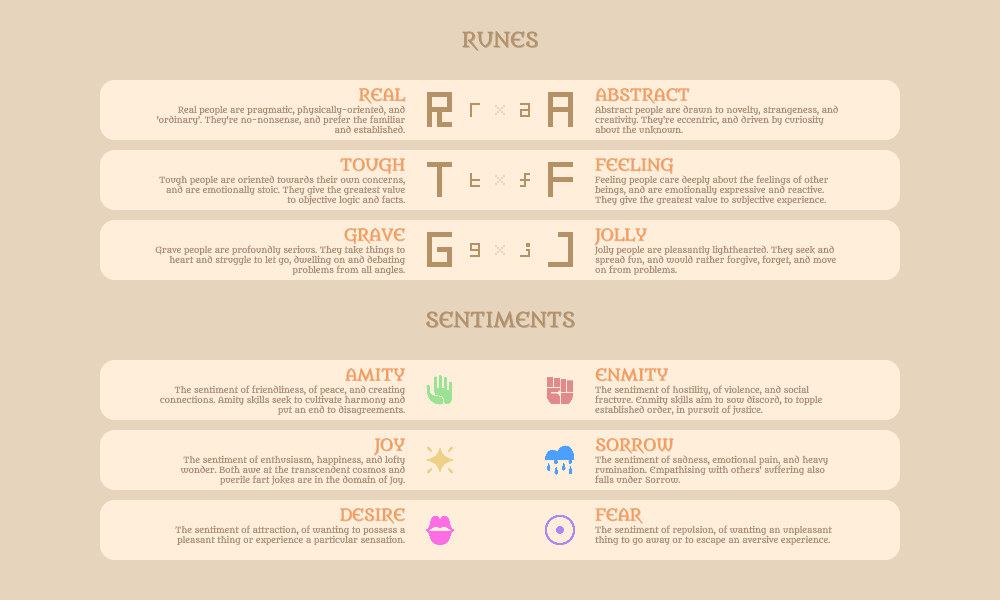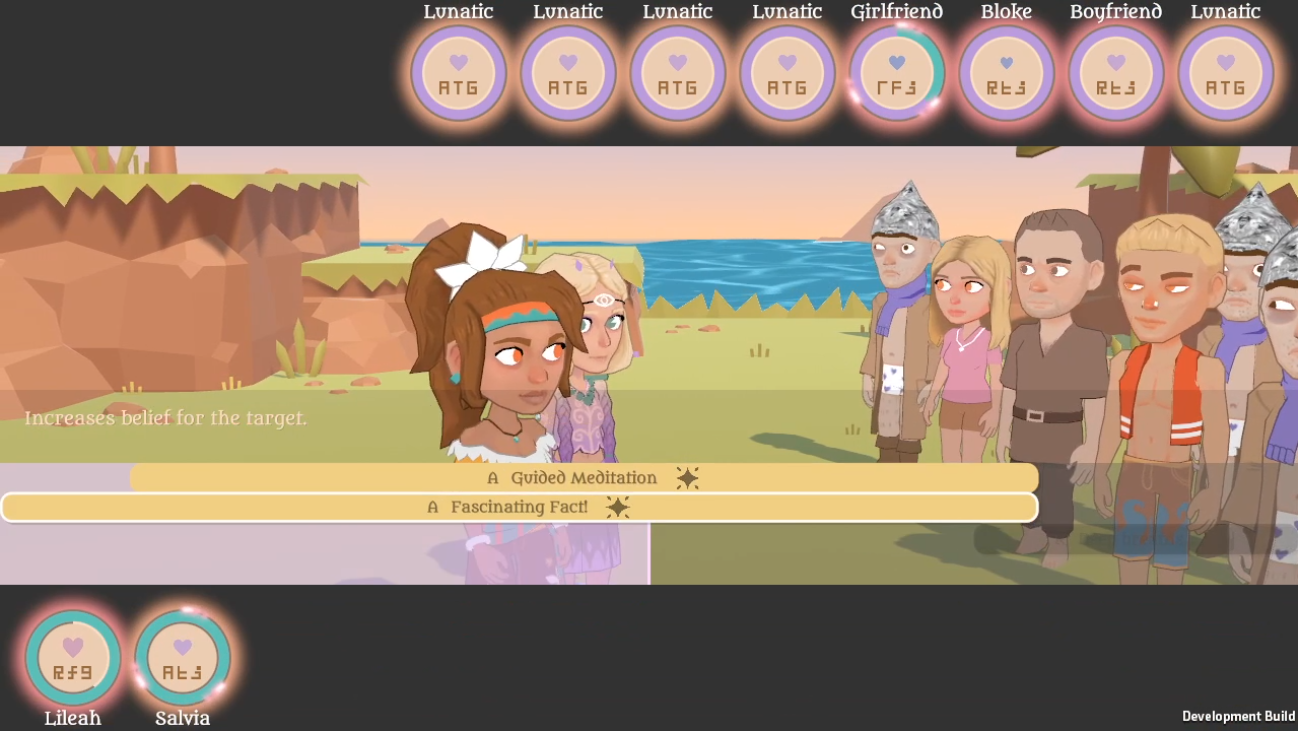DEVELOPMENT
5,677
Belief Video Demo!
6 years ago - Edited 6 years ago
Here's a video of Belief, giving a very good idea of the graphical style and gameplay mechanics!
It's quite a long video - 20 minutes - and I'm aware that maybe a minute-or-two-long one would have been more digestible. You don't
have to watch it all to get an idea of how this game will work, but if your curiosity is piqued by the first bits, then there's more there for you if you want it. I'd really recommend watching it with the sound on!
Here's the video:
The 'story' is just a silly temporary thing, so the dialogue and environment here are just for this video. The actual story will be at least somewhat more serious, dealing with themes I've written about in previous posts.
Also, as characters point out in the video itself, it's still early days and all the skills have the same animations and particle effects. When I have the time to change these, giving each skill its own animation and effect, everything will look much more interesting. But for now, you can see how the 'battles' function in a broad-strokes way.
They're 'non-violent', but not
anti-violent, as I've tried to explain in previous posts. They're just an alternative, and one which I think presents a lot of potential for silliness and emotional intrigue which is lacking from typical combat. Already I find just watching the shifting allegiances in these encounters quite enthralling! Though of course mileage will vary.
![]()
Obviously the mechanics will be explained in the game itself; the player won't just be thrown in the deep end! But here's a brief summary of what's going on:
The point is to fill up the opponents' belief bar with your side's colour until they convert to your side. You win when everyone converts to your side, or lose when everyone on your side converts to the other one. You can lose characters - including the protagonists - mid-'battle', but can win them back.
Characters don't have stats in the traditional sense, like Attack or Defence or even Speed or whatever. Instead, there are three variables that affect essentially everything:
Excitement is represented by the size, speed, and colour of the beating hearts, and it varies from 0 to 100%. It's altered by
rousing or
calming skills. Excitement affects turn order; characters with more excitement effectively have a higher speed stat. It also affects the power of skills, so characters with higher excitement both inflict more 'influence' (what 'damage' is called here)
and receive more as well; it's double-edged. Finally, it affects which skills are available to you. Each character can equip up to four skills from their personal arsenal, and each one has a range of excitement for which it's available (but no cost or cooldown otherwise). Encounters are largely about manipulating excitement.
Runes are the letters like
AFG or
rtj. These represent personality in a story sense, but they're also mechanically used for skill effectiveness. Each skill has an associated rune, and the effectiveness of that skill is increased if the skill's rune is
similar to the user's
and the target's, and reduced if the rune is quite different. Runes come in pairs, and represent spectra, so for example the first rune (Real/Abstract) has the potential values
A,
a,
x,
r, and
R. A character with an
A rune using a skill with an
A rune on a target with an
A rune would be very effective since all the runes match, but if that same character used an
R skill on the same
A target, it'd be very weak because the
R is very unlike both the user's
A and the target's
A. Obvious, right?!? Runes can be shifted, so when you see text like "Abstract+", that's moving the first rune further towards that
A. "Real+" (not "Abstract-") would shift it in the other direction. "Abstract++" would shift it two steps, so an
r would become an
a, or an
x would become an
A.
I'm aware this isn't as obvious to a naive observer as "a bigger attack stat makes you deal more damage". But I think it's more
interesting, especially since the runes also convey information about the character's personality, so it blends together gameplay and story in a way I find very appealing.
The third variable is
moods. These come in pairs too, and characters can have one from each pair at once, so three in total; they can be Aroused and Crying at the same time because they're not opposed, but not Aroused and Panicking at the same time because those are opposed, for example. Skills have a corresponding sentiment as well as a rune. Like with runes, similarity produces greater effectiveness. A Crying character using a Sorrow skill on a Crying character will be very effective, while a Laughing character using a Sorrow skill on a Laughing character will be very ineffective. In a nutshell, moods boost both the effectiveness of skills of that sentiment,
and vulnerability to that same sentiment; again, it's double-edged. However, moods also grant resistance to the opposite sentiment, so a Crying person won't be affected as much by Joy skills. So it's multi-faceted! Characters don't have innate sentiments, so mood isn't taken into account at all if neither the user nor the target have any.
This is a system that I think produces a whole lot of potential for nonlinear interactions. Everything's based on changeable states rather than largely fixed innate characteristics, and I just think it's incredibly interesting! Similarity between battles was something that always bothered me about JRPGs (often I'd just Attack over and over, especially when doing anything else cost MP and wasn't worth it on worthless random encounters), and this addresses that by making each one quite different.
It'd be introduced gradually to the player in the actual game, but there are a couple of things to alleviate the learning curve. One is that you'd be able to press a key at any time to make this image appear (which is shown
hilariously briefly in the video):
![]()
That doesn't actually explain the mechanics exactly, but I can imagine "how am I supposed to remember all these things?" being an objection (or rather it already has been), so with this, you don't. If you aren't sure which runes are paired, the answer is just a button press away. And, like with the convoluted Pokemon type relationships (why does Bug beat Dark or Fire beat Fairy? Or wait, is it Fairy beats Fire?), experience would bring familiarity, so eventually you wouldn't need to check anymore.
Another, more important thing is that when you're choosing an skill to use, you see something like this:
![]()
The circles glow in colours that represent how effective the skill you're readying will be. The 'hotter' the colour, the more effective, so blue means quite ineffective, purple is a bit more effective, then red, and finally gold means very effective indeed (the multipliers range from 20% when everything's off to 400% in the most ideal situation). Here, Salvia is readying an Abstract skill, so the A-runed opponents glow gold (rune similarity) while the Real ones are more red (but it's not
ineffective since the skill matches her own rune at least). The black letterbox bars appear to make these glows as clear as possible.
So I see it like this: You
can intelligently use runes, moods, etc to set up situations to your advantage, but you don't really
have to work them all out mentally every time you take a turn. Mostly it'd be a case of choosing the warmest-glowing target, not really thinking very much about it, letting things just flow naturally. You'd probably be able to get by in most situations just by doing that, though a deeper understanding of the mechanics would give you an edge, which is how it is in most games.
It's less complicated than some systems like Dungeons & Dragons, which have an audience despite their complexity.
That's the gist of how it works. I think it has a lot of potential, but then again I thought that about Sindrel Song, so maybe I'm making the same mistakes again and appealing to thoughtfulness more that the average player is willing to give?
![]()
Also, I quite like how the graphics and music turned out! Using a tile-based approach seems like a good decision I wish I'd made sooner; I might talk in more detail about the path that led to that in another post rather than rambling about it here (I already touched on it a bit in the previous post). The overall vibe I'm going for is one of novelty, but with nostalgic reference to the old games that I made in the past. It's very much a 3D version of what I used to make and what I'm familiar with, so hopefully it'll appeal to the more open-minded of my old fans, if not the ones who want a perfect replication of an experience from their younger years.
I was unsure about the proportions of the characters at first, especially the relatively realistic faces on the super-deformed bodies, but now that I've made a few different NPCs, I think it works okay? Again it's a reference to how characters in my old games - and old JRPGs in general - were proportioned, to some degree. The huge faces also make the important expressions highly visible.
With the 'battle' music, I was going for something overly dramatic in a slightly silly way, which made these social encounters feel like ridiculous over-the-top bouts of critical importance. At first I was wondering whether to do something more relaxed, even jazzy, but now that I've got this, it just feels perfect for the mood I was hoping to convey.
Both the music tracks were done in one morning - as Salvia points out in the video and I did in my previous post - and I was seeing them as temporary placeholders for that reason, just to give the video a bit more life. They've really grown on me now though, so I might end up keeping them in the final game.
![]()
I'll be very interested to hear your impressions of this! Personally it feels way more
alive to me now than it did just a week or two ago, and I really feel I'm onto something here. But I'm also bracing myself for criticisms about how it's too complicated or flawed in this way or that which is always discouraging, but that's how some people seem to be...
One thing I want to point out again is how the Earthbound/MOTHER games are a big inspiration. They've attracted a not-enormous but very loyal following due to their quirkiness, and it's a similar kind of quirkiness I'm aiming for with this. I'm not exactly aiming to target the Call of Duty crowd or whatever.







17